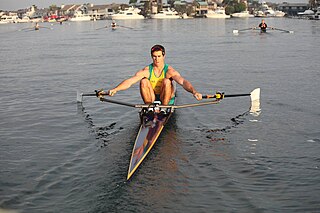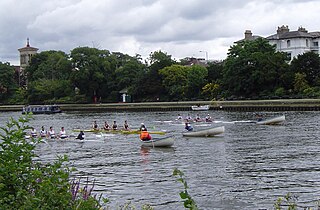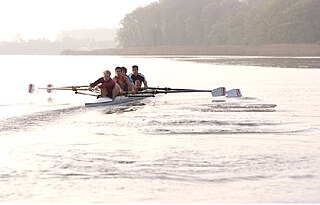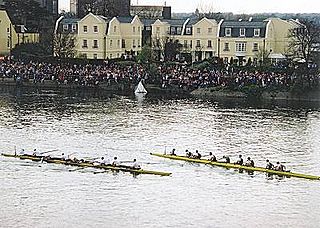Rowers
Examples are given for the largest common boat, the sweep oar eight (which is always coxed), but the same principles apply to smaller boats, sculling boats, and coxless boats.
Stern pair
The "stroke" is the rower closest to the stern of the boat and usually the most competitive rower in the crew. Everyone else follows the stroke's timing - placing their blades in and out of the water at the same time as stroke. The stroke can communicate with the coxswain (when in a stern coxed boat) to give feedback on how the boat feels. During a race, it is the stroke's responsibility to establish the crew's rate (number of strokes per minute) and rhythm. (In coxed boats, the coxswain will assist the stroke in establishing the rate). Because of the great responsibilities, the rower in the stroke seat will usually be one of the most technically sound members of the boat, capable of setting a good rhythm. The stroke is typically the best rower in the boat.

The next rower ('seven' in an eight) sits directly behind stroke and is typically both fit and skilled: this rower acts as a buffer between the stroke and the rest of the crew. They closely follow the rhythm set by the stroke and help transmit this rhythm to the rest of the boat, and particularly to the rowers rowing on the same side as seven, since rowers tend to look at the blades on their side of the boat to check their timing. If the stroke increases or decreases the stroke rate it is essential that seven follows this change so that it is translated to the rest of the crew. Number seven usually watches the back of stroke so that they can time when to move up the slide and copy their rhythm. The job of seven is to emulate the rhythm of the stroke.
Middle crew
The middle rowers of a crew (numbers 2 and 3 in a four/quad, and 3, 4, 5 and 6 in an eight) are normally the most powerful and heaviest rowers, colloquially known as the Fuel Tank, Engine Room, Power House, Big Watts or Meat Wagon. [1] The boat pitches and yaws less in the middle, and the rowers there have less effect on these movements, being closer to the centre of mass and centre of buoyancy. Therefore, the rowers in the middle of the boat do not have to be as technically sound or reactive to the movements of the boat, and can focus more on pulling as hard as they can. [2] It is common practice among crews to put the most technically proficient rowers at the bow and stern and the physically strongest and heaviest rowers in the centre.
Bow pair
The rower closest to the bow of the boat, is usually called either "bow" or the "bowman". [3] In coxless boats, the bow is often responsible for giving calls to the crew. The bow pair of bow and "two", who are the two rowers closest to the boat's bow, are more responsible for the stability (called "set") and the direction of the boat than any other pair of rowers, and are often very technical rowers. The bow of a stern-coxed boat is subject to the greatest amount of pitching, requiring the bow pair to be adaptable and quick in their movements.
Boats that are bow coxed rely on communication between the bow and the cox - as the cox cannot see boats coming up from behind. The bow pair tend to be the smallest of the rowers in the boat. In an 8 boat, bow pair, strength wise, is where the weaker rowers seat. Although weaker, they have some of the best technique out of the whole boat.















